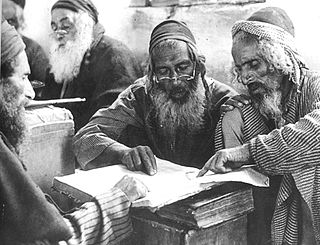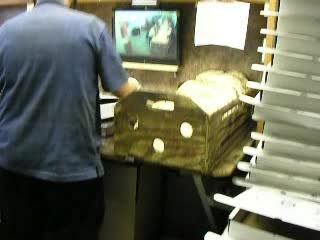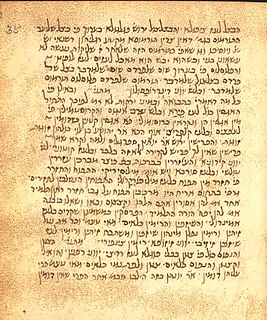Related Research Articles

Shmuel Yosef Agnon was one of the central figures of modern Hebrew literature. In Hebrew, he is known by the acronym Shai Agnon. In English, his works are published under the name S. Y. Agnon.

Sa'adiah ben Yosef Gaon was a prominent rabbi, gaon, Jewish philosopher, and exegete who was active in the Abbasid Caliphate.

The dirham, dirhem or dirhm was a silver coin, and, in some cases, still is a unit of currency in several Arab and Arab influenced states. It was also the related unit of mass.

Yemenite Hebrew, also referred to as Temani Hebrew, is the pronunciation system for Hebrew traditionally used by Yemenite Jews. Yemenite Hebrew has been studied by language scholars, many of whom believe it to retain older phonetic and grammatical features lost elsewhere. Yemenite speakers of Hebrew have garnered considerable praise from language purists because of their use of grammatical features from classical Hebrew. Tunisian rabbi and scholar, Rabbi Meir Mazuz, once said of Yemenites that they are good grammarians.
Dushinsky is one of the few Hasidic dynasties not named after the place where it originated; instead, it is named after the surname of the Rebbe. It is a relatively new dynasty, as are many of the dynasties that originated in Hungary. However, the Dushinsky dynasty truly became a dynasty in Jerusalem, where it is centered today. It is not like other Hasidic groups, in that it does not originate from a Hasidic background, but from the talmidim (students) of the Chasam Sofer.
Sefer ha-Chinuch is a Jewish rabbinic text which systematically discusses the 613 commandments of the Torah. It was published anonymously in 13th-century Spain.
Isaac ben Judah ibn Ghiyyat (1030/1038–1089) was a Spanish rabbi, Biblical commentator, codifier of Jewish law, philosopher, and liturgical poet. He was born and lived in the town of Lucena, where he also headed a rabbinic academy. He died in Cordoba.
Yosef Qafiḥ, widely known as Rabbi Yosef Kapach, was a Yemenite-Israeli authority on Jewish religious law (halakha), a dayan of the Supreme Rabbinical Court in Israel, and one of the foremost leaders of the Yemenite Jewish community in Israel, where he was sought after by non-Yemenites as well. He is widely known for his editions and translations of the works of Maimonides, Saadia Gaon, and other early rabbinic authorities (Rishonim), particularly his restoration of the Mishneh Torah from old Yemenite manuscripts and his accompanying commentary culled from close to 300 additional commentators and with original insights. He was the grandson of Rabbi Yiḥyah Qafiḥ, a prominent Yemenite leader and founder of the Dor Deah movement in Yemen. Qafih was the recipient of many awards, as well as an Honorary Doctorate from Bar-Ilan University.
Simeon ben Zemah Duran, also Tzemach Duran, known as Rashbatz or Tashbatz was a Rabbinical authority, student of philosophy, astronomy, mathematics, and especially of medicine, which he practised for a number of years at Palma. A major 15th century posek, his published decisions in matters of Halacha have been widely quoted in halachic literature for hundreds of years.
Joseph ibn Habiba, also known as Joseph Havivah and Nimmukei Yosef, after the title of his book, was a Spanish Talmudist who flourished in the 14th and 15th centuries. He lived in Barcelona.
Samuel ben Hofni. He was the Gaon of Sura from 998 to 1012.

The tithe is specifically mentioned in the Books of Leviticus, Numbers and Deuteronomy. The tithe system was organized in a seven-year cycle, the seventh-year corresponding to the Shemittah-cycle in which year tithes were broken-off, and in every third and sixth-year of this cycle the second tithe replaced with the poor man's tithe. These tithes were akin to taxes for the people of Israel and were mandatory, not optional giving. This tithe was distributed locally "within thy gates" to support the Levites and assist the poor. Every year, Bikkurim, terumah, ma'aser rishon and terumat ma'aser were separated from the grain, wine and oil. Initially, the commandment to separate tithes from one's produce only applied when the entire nation of Israel had settled in the Land of Israel. The Returnees from the Babylonian exile who had resettled the country were a Jewish minority, and who, although they were not obligated to tithe their produce, put themselves under a voluntary bind to do so, and which practice became obligatory upon all.
Joseph ben Samuel Bonfils was a French rabbi, Talmudist, Bible commentator, and payyetan of the mid-eleventh century. He is also known by the Hebrew name Yosef Tov Elem, a Hebrew translation from the French name "Bonfils."
The House of Hillel and House of Shammai were, among Jewish scholars, two schools of thought during the period of tannaim, named after the sages Hillel and Shammai who founded them. These two schools had vigorous debates on matters of ritual practice, ethics, and theology which were critical for the shaping of the Oral Law and Judaism as it is today.

In Judaism, the dough offering is a positive commandment requiring the owner of a bread dough to give a part of the kneaded dough to a kohen. The obligation to separate the dough offering from the dough begins the moment the dough is kneaded, but may also be separated after the loaves are baked. This commandment is one of the twenty-four kohanic gifts, and, by a biblical injunction, is only obligatory in the Land of Israel, but from a rabbinic injunction applies also to breadstuffs made outside the Land of Israel.
Demai is a Halakhic term meaning "doubtful". The demai status applies to agricultural produce acquired from common people who are suspected of not correctly separating tithes according to Jewish law. As a result, one who acquires demai produce must separate some of the tithes himself, in case this was not done earlier.

Avraham Al-Naddaf (1866–1940), the son of Ḥayim b. Salem Al-Naddaf, was a Yemenite rabbi and scholar who immigrated to Ottoman Palestine in 1891, eventually becoming one of the members of the Yemenite rabbinical court (Beit-Din) established in Jerusalem in 1908, and active in public affairs. His maternal grandfather was Rabbi Yiḥya Badiḥi (1803–1887), the renowned sage and author of the Questions & Responsa, Ḥen Ṭov, and a commentary on the laws of ritual slaughter of livestock, Leḥem Todah, who served as the head of Sanaa's largest seat of learning (yeshiva), held in the synagogue, Bayt Saleḥ, before he was forced to flee from Sana'a in 1846 on account of the tyrant, Abū-Zayid b. Ḥasan al-Miṣrī, who persecuted the Jews under the Imam Al-Mutawakkil Muhammad.
Solomon Sirilio (1485–1554), the son of Joseph Sirilio, was a rabbi and author of one of the first commentaries made on the Jerusalem Talmud.

Isaac ben Melchizedek, , was a rabbinic scholar from Siponto, Italy, and one of the first medieval scholars to have composed a commentary on the Mishnah, of which only his commentary on Seder Zera'im survives. Elements of the Mishnaic order of Taharot are also cited in his name by the Tosafists, but the complete work is no longer extant.
Tanhum ben Joseph of Jerusalem, also known as Tanḥum ha-Yerushalmi (1220–1291), was a 13th-century Hebrew lexicographer and biblical exegete who compiled several Hebrew works, the most notable of which being a lexicon on Mishnaic words entitled Murshid al-kāfī. Tanhum's learning in Jewish studies was so pervasive that he was coined the name "the Abraham ibn Ezra of the Levant."
References
 This article incorporates text from a publication now in the public domain : Singer, Isidore; et al., eds. (1901–1906). "Ventura". The Jewish Encyclopedia . New York: Funk & Wagnalls.
This article incorporates text from a publication now in the public domain : Singer, Isidore; et al., eds. (1901–1906). "Ventura". The Jewish Encyclopedia . New York: Funk & Wagnalls.